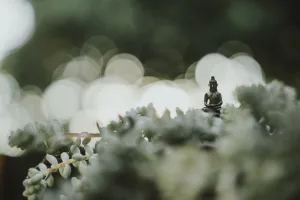In Japanese gardens, certain plants are carefully selected to create a serene and harmonious atmosphere. From delicate cherry blossoms to lush bamboo, each plant has its own significance and purpose. By incorporating evergreens like pine and azalea, as well as vibrant flowers like lotus and iris, Japanese gardens beautifully reflect the changing seasons and emphasize the beauty of nature. Whether it’s the soothing sound of water flowing over rocks or the tranquil sight of moss-covered pathways, the plants in Japanese gardens play a crucial role in creating a peaceful sanctuary for visitors to enjoy.

Understanding Japanese Gardens
Japanese gardens are not just a collection of plants and trees arranged in a pleasing manner. They embody a unique philosophy that reflects the harmonious relationship between nature and humans. The design principles and elements of Japanese gardens are deeply rooted in Japanese culture and heritage.
The philosophy behind Japanese gardens
Japanese gardens are based on the concept of creating a miniature representation of nature. They aim to recreate the serene beauty of the natural world within a confined space. The philosophy behind Japanese gardens emphasizes the importance of balance, harmony, and tranquility.
The design of a Japanese garden is guided by the principle of asymmetry, which brings a sense of naturalness and spontaneity. Every element in the garden, from the arrangement of rocks to the choice of plants, is carefully considered to create a sense of calm and peacefulness.
The importance of nature and plants in Japanese gardens
Nature plays a central role in Japanese gardens, and the choice of plants is essential to create an atmosphere that reflects the changing seasons. Japanese gardens often feature plants that are native to Japan or have a deep cultural significance.
Plants in Japanese gardens are carefully selected to enhance the overall aesthetic and spiritual experience. Each plant is chosen for its shape, texture, color, and ability to create a sense of harmony. The thoughtful combination of trees, flowering plants, shrubs, ground cover, and aquatic plants creates a diverse and visually appealing landscape.
Types of Japanese Gardens
Japanese gardens can be categorized into different types based on their design and purpose. Each type represents a unique approach to creating a tranquil and contemplative space.
Roji (Tea Gardens)
Roji, or tea gardens, are an integral part of the traditional Japanese tea ceremony. These gardens are designed to create a sense of calmness and prepare the mind for the tea ceremony. Roji gardens feature simple and understated designs, with a focus on natural materials such as stone and gravel. The plants in Roji gardens are often chosen for their aromatic qualities, such as evergreen shrubs and fragrant herbs.
Kaiyu-shiki-teien (Stroll Gardens)
Kaiyu-shiki-teien, or stroll gardens, are meant to be experienced through a leisurely walk. These gardens typically feature a circuitous path that allows visitors to explore different areas and enjoy various scenic views. Stroll gardens often include ponds, water features, and bridges, with plants strategically placed to create a sense of depth and perspective. The plants selected for stroll gardens vary depending on the desired atmosphere, but they often include a mix of trees, flowering plants, and shrubs.
Karesansui (Dry Landscape Gardens)
Karesansui, or dry landscape gardens, are minimalist gardens that rely on carefully arranged rocks, gravel, and sand to represent natural elements like mountains, rivers, and islands. These gardens often evoke a sense of tranquility and contemplation through their simplicity and abstract representations. In karesansui gardens, plants are usually limited to mosses, small shrubs, and carefully pruned trees, emphasizing the beauty of the rocks and dry elements.
Essential Trees in Japanese Gardens
Trees are a fundamental element in Japanese gardens, symbolizing strength, longevity, and a deep connection with nature. Here are some of the essential trees commonly found in Japanese gardens:
Japanese Maple (Acer Palmatum)
The Japanese Maple is a beloved tree in Japanese gardens due to its graceful form, vibrant foliage, and ability to change color throughout the seasons. The delicate leaves of the Japanese Maple create a beautiful canopy and provide dappled shade, adding a sense of tranquility to the garden.
Japanese Black Pine (Pinus Thunbergii)
The Japanese Black Pine is a symbol of endurance and resilience. Its distinctive shape and dark green needles make it a striking feature in Japanese gardens. The twisted trunk and branches of the Black Pine add an element of age and character, evoking a sense of wisdom and strength.
Cherry Blossom (Sakura)
Cherry Blossoms, or Sakura, hold a special place in Japanese culture. These delicate flowers symbolize the transient nature of life and the beauty of impermanence. Cherry Blossoms in full bloom create a breathtaking spectacle, attracting visitors from all over the world to Japanese gardens during spring.
Flowering Plants in Japanese Gardens
Flowering plants bring a splash of color and liveliness to Japanese gardens. Here are some of the popular flowering plants commonly seen in Japanese gardens:
Azalea (Rhododendron)
Azaleas are highly valued for their vibrant and showy flowers. These flowering shrubs come in a variety of colors and are often planted in mass numbers to create a stunning display. Azaleas are particularly associated with springtime and are known for their ability to transform the landscape into a vivid sea of colors.
Camellia (Camellia Japonica)
Camellias are renowned for their elegant and waxy blooms. These evergreen shrubs add a touch of sophistication to Japanese gardens, with their glossy leaves and large, intricate flowers. Camellias bloom in late winter or early spring, bringing a burst of color and fragrance during the colder months.
Peony (Paeonia Suffruticosa)
Peonies are highly regarded for their large, showy flowers and intoxicating fragrance. These perennial plants symbolize prosperity, love, and beauty in Japanese culture. Peonies bloom in late spring or early summer and are often used as cut flowers or as focal points in Japanese garden designs.

Common Shrubs in Japanese Gardens
Shrubs are invaluable in creating different layers and visual interest in Japanese gardens. Here are some commonly used shrubs in Japanese garden designs:
Japanese Box (Buxus Microphylla Japonica)
Japanese Box is a versatile evergreen shrub that is often used for hedging or as a foundation plant in Japanese gardens. Its compact form and dense foliage make it an ideal choice for creating sculpted shapes, such as hedges, topiaries, or cloud-pruned forms.
Japanese Andromeda (Pieris Japonica)
Japanese Andromeda is prized for its showy clusters of bell-shaped flowers and vibrant new foliage. This evergreen shrub provides year-round interest with its changing leaf colors and beautiful blooms. Japanese Andromeda is commonly used in Japanese gardens to add texture and a splash of color.
Spreading Yew (Taxus Baccata Repandens)
Spreading Yew is a low-growing shrub that forms a dense carpet of dark green foliage. It is well-suited for creating ground cover or defining borders in Japanese gardens. The spreading habit of this shrub adds a sense of depth and creates a lush and serene atmosphere.
Use of Ground Cover in Japanese Gardens
Ground cover plants play a crucial role in Japanese gardens, filling in the spaces between larger plants and creating a cohesive and harmonious landscape. Here are some commonly used ground cover plants in Japanese gardens:
Japanese Pachysandra (Pachysandra Terminalis)
Japanese Pachysandra is a popular ground cover that forms a dense carpet of glossy, deep green leaves. This shade-tolerant plant is often used under trees or along pathways in Japanese gardens, providing a lush and tranquil setting. Pachysandra’s ability to spread and control weeds makes it an excellent choice for ground cover.
Moss (Ryomenzan)
Moss is highly valued in Japanese gardens for its ability to create a sense of timelessness and tranquility. It thrives in cool and moist environments and is often found growing on rocks, paths, and around water features. The velvety texture and vibrant green color of moss add a touch of serenity and natural beauty to Japanese gardens.
Sweet Flag (Acorus Gramineus)
Sweet Flag is a versatile plant that combines attractive foliage with a pleasant fragrance. Its grass-like leaves form dense clumps, making it an ideal choice for ground cover in Japanese gardens. Sweet Flag thrives in moist soil and is often used to create borders along ponds or waterlogged areas, adding a touch of elegance.

Aquatic Plants in Japanese Gardens
Water features are a key element in Japanese gardens, and the selection of aquatic plants adds depth and serenity to these spaces. Here are some commonly used aquatic plants in Japanese gardens:
Lotus Flower (Nelumbo Nucifera)
Lotus Flowers hold great cultural significance in Japan and are often associated with enlightenment and purity. These aquatic plants have striking flowers that float on the water’s surface, creating a stunning visual display. Lotus flowers are commonly found in ponds and water gardens, adding a touch of elegance to the overall landscape.
Japanese Water Iris (Iris Ensata)
Japanese Water Iris is known for its vibrant, showy blooms and sword-like foliage. These aquatic plants can be found growing along the edges of ponds or submerged in shallow water. Japanese Water Iris offers a burst of color and texture to Japanese gardens, attracting attention with their bold and beautiful flowers.
Duckweed (Lemna Minor)
Duckweed is a small floating plant that quickly covers the surface of still water bodies. Although it may seem insignificant, duckweed plays a vital role in Japanese gardens by providing shade, reducing algae growth, and improving water quality. Its presence adds a natural and authentic touch to the water features in Japanese gardens.
Herbs and Grasses in Japanese Gardens
Herbs and grasses are often used in Japanese gardens to create texture, movement, and a sense of wildness. Here are some commonly used herbs and grasses in Japanese garden designs:
Japanese Blood Grass (Imperata Cylindrica)
Japanese Blood Grass is highly valued for its vibrant red leaves and striking appearance. This ornamental grass adds a dramatic touch to Japanese gardens, especially when planted in mass numbers or as accents. The upright growth habit and unique coloration of Japanese Blood Grass create a visual focal point and a touch of excitement.
Japanese Silver Grass (Miscanthus Sinensis)
Japanese Silver Grass is a graceful and elegant grass that adds a sense of movement and softness to Japanese gardens. This ornamental grass features cascading foliage and decorative flower plumes that sway with the breeze. Japanese Silver Grass is commonly used in borders, as specimen plants, or to create a sense of privacy and enclosure.
Bamboo (Bambusoideae)
Bamboo holds a special place in Japanese culture and is an iconic element in Japanese gardens. The tall and stalky nature of bamboo creates a vertical element that offers a sense of structure and privacy. Bamboo is often used as a backdrop or as a living fence in Japanese gardens, adding a touch of simplicity and elegance.
Ferns and Vines in Japanese Gardens
Ferns and vines are valued for their lush and vibrant foliage, which adds texture, depth, and a sense of naturalness to Japanese gardens. Here are some commonly used ferns and vines in Japanese garden designs:
Japanese Climbing Fern (Lygodium Japonicum)
Japanese Climbing Fern is a graceful and delicate vine that adds a sense of lightness and movement to Japanese gardens. This vine wraps around trees or structures, creating a visually captivating effect. The finely divided fronds of the Japanese Climbing Fern lend a soft and ethereal quality to the garden.
Japanese Hydrangea Vine (Schizophragma Hydrangeoides)
Japanese Hydrangea Vine is a robust and vigorous climber that produces large, creamy white flowers. This vine is often used to cover walls, fences, or trellises in Japanese gardens, providing a stunning backdrop for other plants. The abundant and showy flowers of the Japanese Hydrangea Vine add a touch of elegance and beauty to the garden.
Boston Ivy (Parthenocissus Tricuspidata)
Boston Ivy is a deciduous vine that is valued for its vibrant fall foliage. The leaves of Boston Ivy turn a spectacular red color in autumn, creating a dramatic visual display. This vine is often used to cover walls or climb over pergolas in Japanese gardens, adding a touch of seasonal interest and a sense of coziness.
The Use of Plant Symbolism in Japanese Gardens
Plants in Japanese gardens are not merely decorative elements but also carry deep symbolic meanings. Here is a glimpse into the symbolism of plants in Japanese gardens:
Symbolism of trees in Japanese gardens
Trees in Japanese gardens symbolize strength, longevity, and connection with nature. They represent the cycle of life, with changing seasons mirroring the impermanence and transience of all things. Different trees carry different meanings, such as the Japanese Maple symbolizing grace and beauty, the Japanese Black Pine representing endurance and resilience, and the Cherry Blossom representing the beauty of fleeting moments.
Symbolism of flowers in Japanese gardens
Flowers in Japanese gardens often symbolize specific virtues, emotions, or seasons. For example, the Cherry Blossom represents the beauty and fragility of life, while Peonies symbolize prosperity, love, and nobility. Flowers in Japanese gardens are carefully chosen to create an atmosphere that reflects the changing seasons and evokes a sense of wonder and appreciation for nature’s beauty.
Bamboo and its symbol in Japanese gardens
Bamboo holds a special place in Japanese gardens and is highly valued for its various symbolic meanings. It represents strength, flexibility, and resilience. The straight, vertical growth of bamboo evokes a sense of structure and tranquility, while its ability to bend without breaking symbolizes adaptability and harmony in the face of challenges. Bamboo is often used as a symbol of the human spirit and the pursuit of personal growth within Japanese garden designs.
In conclusion, Japanese gardens are a testament to the deep connection between humans and nature. They embody a unique philosophy that emphasizes balance, harmony, and tranquility. Through the careful selection and arrangement of plants, Japanese gardens create a serene and contemplative space that invites reflection and appreciation for the beauty of the natural world. Whether it’s the elegant Japanese Maple, the vibrant Azalea, or the symbolic Bamboo, each plant in a Japanese garden contributes to the overall aesthetic and spiritual experience, allowing visitors to immerse themselves in nature’s tranquility.




